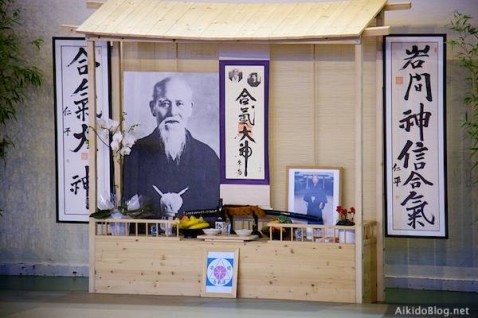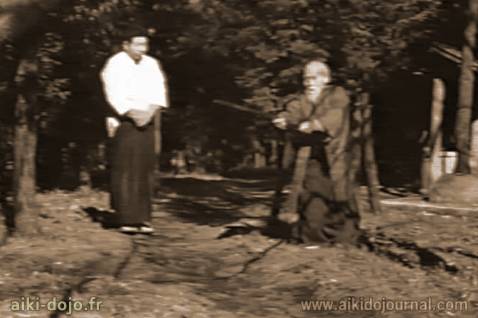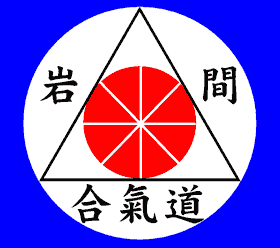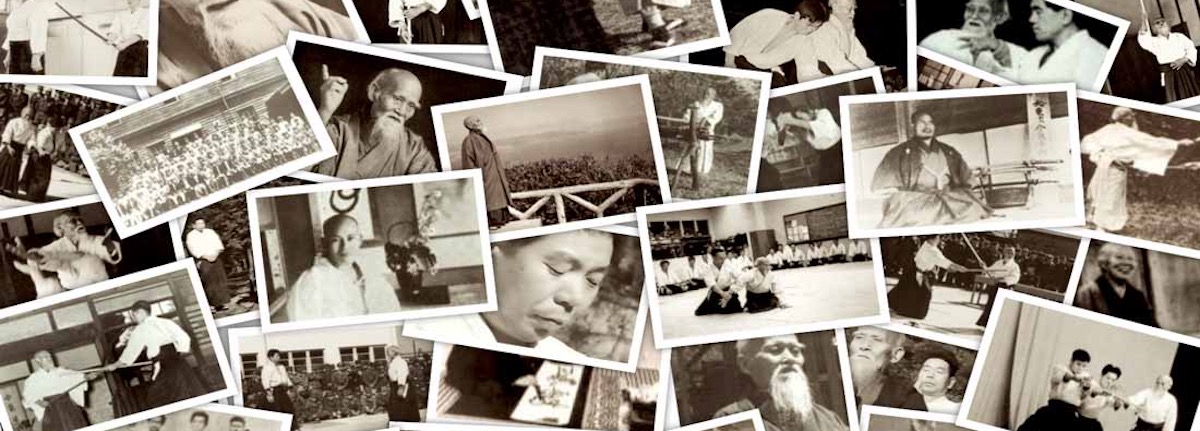SAITO Hitohira Sensei
Interview made by Olivier EBERHARDT
Seminar in Rennes 11/2014
Translation: Charles DURAND / Olivier EBERHARDT © 2015 Dento Iwama Ryu France – Olivier EBERHARDT
Here is an instrustructive interview done by Olivier EBERHARTD during the 3rd coming in France of SAITO Hitohiro Sensei as some soke of Iwama Shinshin Aiki Shuren Kai.

Interview
Relationship with UESHIBA family
O. Eberhardt : Master Saito, what relationship do the SAITO and UESHIBA families have?
Saito H. : My father became a disciple of O-Sensei in 1945 and followed his teachings until the death of O-Sensei in 1969. My father received from the Founder a land located right next to his house, where he built the house where I still live today. O-Sensei had great affection for my father. My mother also served the Ueshiba family for eighteen years.

Even if I took my independence, I’m still very grateful to the Ueshiba family. Moreover, this independence, I took it after receiving the authorization and approval of the third Doshu UESHIBA Moriteru. Thus, there is no dispute between us and Moriteru Sensei is for me like a big brother. The sustainability of the Ueshiba family is very important to me, and I sincerely hope that Ueshiba and Saito families will retain that student-teacher relationship in the future.

Calligraphies de O’Sensei expliquant le symbolisme du triangle, cercle et carré.
What make Iwama Shurenkai
O. Eberhardt : Master Saito, what are the distinctive features of training (keiko) in your Iwama Shinshin Aiki Shuren Kai school?
Saito H. : Before talking about the characteristics of training (keiko), it is important to keep in mind that my father, Morihiro Saito, was the direct disciple of O-Sensei for many years and that he then headed the Dojo O -Sensei until his death. All this lasted half a century, 50 years…
My father transmitted me the Aikido as O-Sensei practiced it and which was based on three fundamental elements: the practice of weapons (bukiwaza), practice of barehanded techniques (taijutsu) and the Shinto spirituality. Today, only the Shinshin Iwama style Aikido offers a faithful practice of O-Sensei’s Aikido. A practice that simultaneously integrates these three fundamental elements.
O-Sensei had many disciples. Of these, some have taken early independence. Others stayed at the Aikikai but among them, few have really understood really deeply the teaching of O-Sensei. In this context, my father stayed 23 years with O-Sensei whom directly transmitted his teaching to him. My father practiced every day directly with O-Sensei, and he transmitted this same teaching in Iwama dojo. And I’m only perpetuating this legacy: our practice faithfully reproduces all aspects of the Aikido O-Sensei practiced.
In terms of training, there is a point which many people are mislead. In Budo, the rule is simple: if you are immobilized by a grasp and you cannot free yourself, you’re dead.
The first base of Budo is therefore to be able to rid yourself of a real grasp, powerful and immobilizing. That’s why it is essential that the practitioner trains first in the worst position, being static. Obviously, the ultimate goal is to be able to dodge before the opponent gets a hold or grasp and use techniques in a dynamic way. But, imagine what happens if for any reason, such as an error in timing caused the inability to dodge an attack in time. You’re dead. That is why we consider so importantly, first base, to train on techniques from the most dangerous or difficult position or situation for ourselves.
The first step is learning what to do in specific cases. Then the practitioner gradually integrates all these bases in his body and gradually becomes able to perform techniques in a dynamic way.
This step by step progression is not unique to Aikido. It also exists in calligraphy where it is reflected in three writing styles (Kaisho, Gyosho and Sosho) (1), and it is exactly the same in Budo.
Better yet, it’s the same in all parts of life: such as someone riding a bike for the first time, at the beginning he doesn’t succeed because he has no balance. He gets it little by little, as he keeps on biking. He progresses as he integrates the different sensations in his body. For us, training is following the same path. Our training method consists in starting with the most unfavorable and realistic position, static: we learn how to perform the techniques correctly, to remain stable and to unbalance the opponent. Gradually you acquire more and more technical precisions with angles, timing, and one day you become able to fully realize the techniques in a dynamic way. The purpose of Aikido is of course to practice dynamic techniques, but to be ever able to do this, you must pass through a binding static learning. It is impossible to understand the best dodge timing while your body has not integrated the time and point at which it is immobilized.
The training (keiko) can not be limited to the execution of techniques in ideal conditions of ease.
This is also an attitude toward life: how about when you are not in shape or when you are sick? Real life, does not always offer favorable action conditions. What is to be done when you have a locked foot when it’s dark, and can not react with the right timing? Since ancient times, the Japanese pay a particular attention to the work of basics, because they know that context brings different situations and not necessarily optimal ones: disease, mud, night…
Incorporating these bases, or not, is what makes the difference in critical moments, shielding your life or not. Of course there are very strong people everywhere, regardless of the training method, but for the majority of us to really achieve this, the starting point of keiko (training) is to integrate the less favorable situations from the beginning. This is true in every Budo.
This is the approach of the Iwama style Aikido, and is the one taught by O-Sensei. We are true to it.
As mentioned above, we progress by stages and we must first be able to move even when being strongly seized / immobilized. O-Sensei said « kashiri tsumete » in the dialect of the Wakayama region. This means « grasp firmly ». For him, a true Budo practitioner must learn to move even when firmly grasped / immobilized. It is not necessary to loosen the grasp because your partner is blocked , otherwise Budo becomes meaningless. It is not enough to explain that « normally just do this or that in a particular situation and a particular timing. » This type of education does not meet the true spirit of Budo. It only « says what should happen ideally » in this or that situation, but does not teach how to reach this ideal level. All this is not realistic and that’s why my teaching starts with the basics: what to do in the most unfavorable situation (being locked)…
But I did not invent this practice way, it’s Morihei UESHIBA’s one, that my father and I keep alive.
After 10 years, achievements and outlook
 O. Eberhardt : Sensei, your Shinshin Aiki Shurenkai school celebrated its 10th year of existence in 2014. What do you see when you look back on these years, and what outlook do you have?
O. Eberhardt : Sensei, your Shinshin Aiki Shurenkai school celebrated its 10th year of existence in 2014. What do you see when you look back on these years, and what outlook do you have?
Saito H. : However, these two currents come from the same single source: O-Sensei. Thus, it is not accurate to say that we practice something completely different.
On the other hand, our visions are not the same and it appears in our teachings and practicing styles. In Tokyo (Aïkikai), people practice from the beginning in ki-no-nagare (dynamic), while in Iwama we retain the traditional method. I do not criticize or deny the method followed in Tokyo, because in the end the purpose and form are the same. In both cases excellent Aikidoka are formed.
The teaching in Iwama is perhaps a little hard at first for the beginners, but it is a form of education in which misunderstandings and difficulties diminish gradually.
Indeed, I have doubts about a teaching that does not incorporate the most demanding situations, which prohibits strong grasp, a necessary step to take into account all aspects of reality, but which includes dynamic forms (the highest level).
The effectiveness of this training method is doubtful for some students. That’s one of the reason some of them stop practicing.
In return, the teaching of Ueshiba Sensei is difficult at first. But this doubt vanishes as practice and training progresses, the practical difficulties disappear. To me, the teaching quality is what allows students to progress in solving their doubts and difficulties. Thus, after a decade of practice, we can begin to grasp and understand the treasure bequeathed by my father Morihiro Saito Sensei.
I did not take my independence to be independent, but because I wanted to keep on transmitting the teaching of Morihiro Saito Sensei. Of course this independence took the form of a new structure called Shinshin Aiki Shurenkai. But in fact, it just lives and transmits authentically and faithfully O-Sensei’s traditional way of teaching, respecting and integrating the thoughts of the Founder at the center of the practice. This is how we practice every day that God gives.
I get many ushi-deshi (indwelling students) from all over the world. I try to make them live in the most accurate possible way the training they would have had with the Founder, and this starts with morning prayers. These prayers, that O-Sensei practiced daily, express gratitude to the gods. Prayer and gratitude are a common denominator to all religions in the world. Founder began and ended each day with prayers of gratitude to the Creator. This is in O-Sensei’s memory that our group is called Shinshin Aiki Shurenkai « Shinshin » (神信) means « trust in God ». I chose this name to simply indicate that our Dojo keeps and teaches the Founder’s Budo.
It has been 10 years since I chose this name in remembrance of O-Sensei’s. Since then, there has been moments of joy, of sadness, difficult moments, but those 10 years have passed very quickly. I went through these moments by leaving them to God, and I did what had to be done every day. During this time many people have joined our group, it’s like a family that keeps on growing.
Today, every day is beautiful. When I was young, I was so involved in my practice that I had many accidents, including hips surgery. Still recently I had to have surgery for one of my knees. But even with a damaged body it’s possible to practice if you stay in accordance to the teaching of the Founder. Indeed, the techniques of the Founder do not urge a specific part of the body, but the whole of it at the same time. The pressure on one knee is easily compensated, then. However, since the practice of kihon (basic) strongly urges the lower limbs, I sometimes still feel pain in my knees. But even so I am happy and put each day to good use. Yes, those 10 years have flown by very quickly.
In terms of outlook, I will soon be 60 years old and I think my role is now to share and transmit O-Sensei’s teaching to one more person at least. The role the Founder had given himself was to purify this world of wars and create heaven on Earth. And to the question of knowing where this paradise is, the conclusion he had reached was that paradise is us all, in our hearts. I heard him saying that « discovering this is the very purpose of Aikido. » I would be very happy if even only one more person understood this. My mission is to convey the teachings of Ueshiba Sensei and my father Morihiro Saito Sensei – « Morihiro » is the Aikido name that O-Sensei gave to my father –
Though and because Aikido is now always represented by the Ueshiba family I now have to prepare the continuation with a new generation, starting with my two sons Yasuhiro and Mitsuyoshi, who practice Aikido. I will encourage and help them in their undertaking. At the same time, Moriteru Ueshiba Sensei is sparing no efforts, his son Mitsuru Ueshiba the 4th Doshu is now a man. I wish that the Ueshiba and Saito families maintain good relations in the future.
Leadership comes down to the Ueshiba family, and mine historically supports her. I really wish to preserve this form of thought in the future.
That’s what I say to my sons every day. But at the same time, we must protect, conserve and transmit the traditional techniques of Iwama: this is all the work and legacy of my father. All those who enjoy this form of thought are our friends, but we have nothing against those who do not share these values, or who do not know Aikido. What really matters is that these traditional values live and spread.
These values are the soul of Japan, and belong to Shinto or Buddhism. I practice them in Shinto, as the Founder did: the day begins with prayer and meditation, then begins keiko (training), then the day is spent working in the fields as we were taught by O-Sensei.
This is because Moriteru Ueshiba Sensei allowed me to take my independence that I have the time to live well, just as the Founder did. Formerly, my father and I had to take care of the Founder’s Dojo, the Aiki-Jinja with all it entails. We were very busy even though we had time to work in the fields and give the Gods its fruits as offerings. Independent, I can truly follow O-Sensei’s way of life. For this too I am very grateful to the Ueshiba family. I am also very grateful to all those who are involved today in the Founder’s Dojo and the Aiki-Jinja.
10 years ago, I experienced a certain kind of stress. But today, I feel nothing but gratitude. Each day is gratitude. For this seminar in France, in Rennes, I also feel gratitude. For me, this is guided by O-Sensei. I think happiness is to practice Aikido daily. I really thank you.
(1) Calligraphy (shodo 書道) has three Japanese writing styles that are linked sequentially and correspond to control steps. The first style taught is called « Kaisho » and consists of strictly centered characters with prominents angles and in which every detail is harshly checked. This first style is aimed to acquire the basics. It is characterized by a static print. The second style is called “Gyosho”: characters are still close to the Kaisho style but show more dynamic curves and render the moves of the brush. Characters written in the third style, called “Sosho” or « grass writing », are illegible to neophytes, their shapes are linked as they render the very movement of the brush. Each of these styles is a step that requires prior mastery of the previous style.
Source
Publiched 14 février 2015 – Last Updated on 19 avril 2015 by Eric Savalli / Aikido Blog .net
